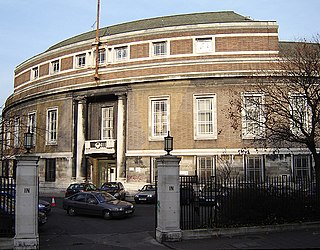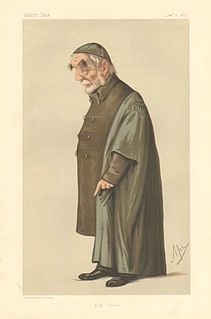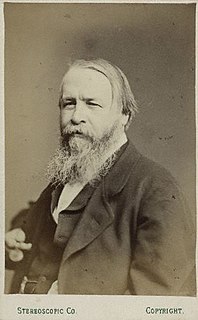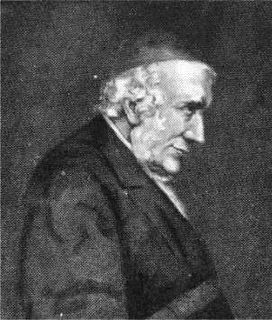
The Oxford Movement was a movement of High Church members of the Church of England which eventually developed into Anglo-Catholicism. The movement, whose original devotees were mostly associated with the University of Oxford, argued for the reinstatement of some older Christian traditions of faith and their inclusion into Anglican liturgy and theology. They thought of Anglicanism as one of three branches of the One, Holy, catholic, and Apostolic Church.
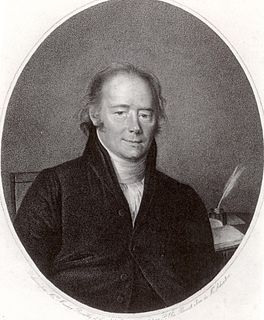
William Allen was an English scientist and philanthropist who opposed slavery and engaged in schemes of social and penal improvement in early nineteenth-century England.

James Syme FRCSEd, FRSE DDL was a pioneering Scottish surgeon.
Stoke Newington was an ancient parish in the county of Middlesex. It was both a civil parish, used for administrative purposes, and an ecclesiastical parish of the Church of England.

Hackney is a parish in the historic county of Middlesex. The parish church of St John-at-Hackney was built in 1789, replacing the nearby former 16th-century parish church dedicated to St Augustine. The original tower of that church was retained to hold the bells until the new church could be strengthened; the bells were finally removed to the new St John's in 1854. See details of other, more modern, churches within the original parish boundaries below.
Mary, Lady Abney inherited the Manor of Stoke Newington in 1701 from her brother. The property lies about five miles north of St Paul's Cathedral in the City of London. She had a great influence on the design and landscaping of Abney Park, including the planting of the two elm walks that lead to Hackney Brook.
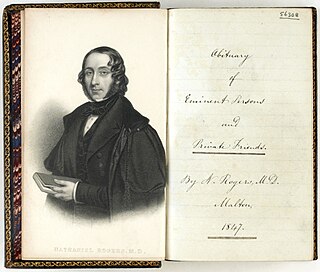
Nathaniel Rogers M.D. was a doctor of medicine who qualified at Edinburgh University in 1832 and practiced in Malton, Yorkshire in his early career, later moving to London and then, during semi-retirement spent his winter seasons at Exeter. He is known more widely as the donor of stained glass windows to both Anglican churches and nonconformist chapels. He edited several medical books, authored poems and letters to newspapers, chaired baptist and related meetings, and gave lectures to Mechanics' Institutes and similar educational institutes in London and North Yorkshire.

St Matthias Church is an Anglican church in Stoke Newington, north London, England, and was once one of London’s foremost High Churches.
Medical missions in China by Protestant Christian physicians and surgeons of the 19th and early 20th centuries laid many foundations for modern medicine in China. Western medical missionaries established the first modern clinics and hospitals, provided the first training for nurses, and opened the first medical schools in China. Work was also done in opposition to the abuse of opium. Medical treatment and care came to many Chinese who were addicted, and eventually public and official opinion was influenced in favor of bringing an end to the destructive trade.
John David Jenkins was a Welsh clergyman and historian. He spent six years ministering in Pietermaritzburg; after his return to England, he became known as the "Rail men's Apostle" for his work with railway workers in Oxford. He was Vice-President, and then President, of the Amalgamated Society of Railway Servants. He also wrote a book on the history of the church.

Dr. Andrew Anderson II was a physician, philanthropist, mayor and benefactor of St. Augustine, Florida. Anderson commissioned multiple works of art to adorn a variety of public spaces in the City of St. Augustine, including the two Medici lion statues placed at the approach to the famed Bridge of Lions.

The Roman Catholic Church is the largest non-government provider of health care services in the world. It has around 18,000 clinics, 16,000 homes for the elderly and those with special needs, and 5,500 hospitals, with 65 percent of them located in developing countries. In 2010, the Church's Pontifical Council for the Pastoral Care of Health Care Workers said that the Church manages 26% of the world's health care facilities. The Church's involvement in health care has ancient origins.
John Egan Moulton was an Australian medical practitioner. He was Chairman of the NSW Institute of Sports Medicine at Concord Hospital, team doctor of the Australian national rugby union team and Honorary Secretary of the Council of Newington College. He was a Fellow of the Royal College of Surgeons of England and Edinburgh and a Fellow of the Royal Australasian College of Surgeons. Moulton was honoured by his nation with the award of the Medal of the Order of Australia for his "service to surgery and medical education particularly in relation to sports medicine."
Sir James Frederic Goodhart, 1st Baronet was an English physician and paediatrician.
William Pennefather (1816-1873) was an Irish Anglican cleric who spent most of his adult life in England. He was celebrated for his hymns and sermons, and also for his missionary work.

Arthur Margoschis was a Protestant Christian missionary in India. He served the Society for the Propagation of the Gospel in Foreign Parts (SPG) as an overseas missionary in India. The inhabitants of Nazareth, a small town in Tamil Nadu, called him the "Father of Nazareth" and Margoschis Aiyar. Aiyar means clergyman in the native language. Reverend Margoschis was responsible for the development of the small town of Nazareth, which is situated at the southern part of Tamil Nadu, India.
Benjamin Fordyce Barker, generally known as Fordyce Baker, (1818-1891) was an obstetrician from Maine who was a visiting physician at Bellevue Hospital from 1855 to 1879 and a consulting physician there from 1879 to his death.


